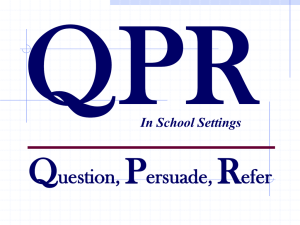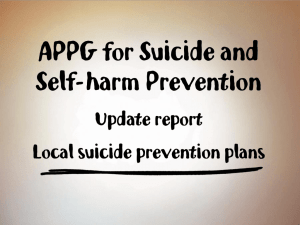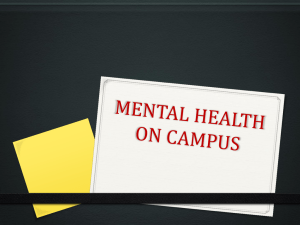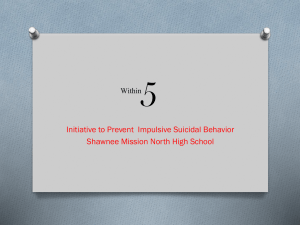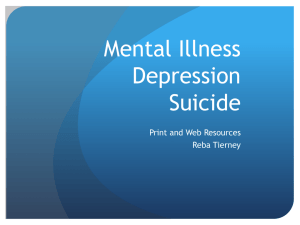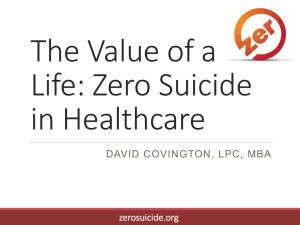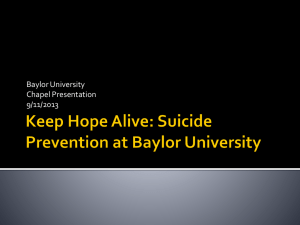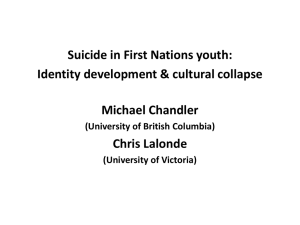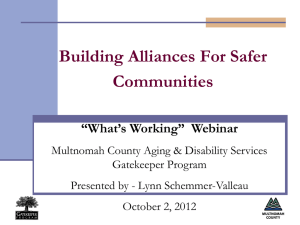Randomized Trial of a Gatekeeper Program for Suicide Prevention
advertisement
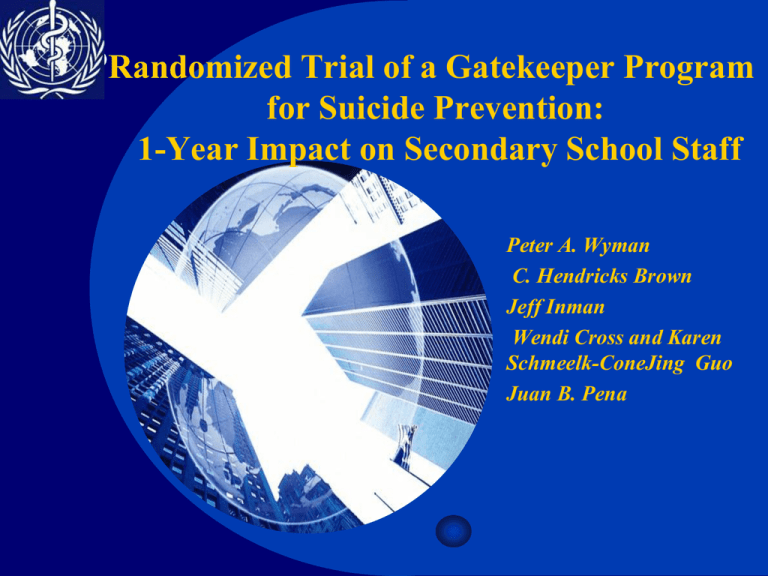
Company LOGORandomized Trial of a Gatekeeper Program for Suicide Prevention: 1-Year Impact on Secondary School Staff Peter A. Wyman C. Hendricks Brown Jeff Inman Wendi Cross and Karen Schmeelk-ConeJing Guo Juan B. Pena Content Introduction Methods Results Introduction Gatekeeper training in schools is one widely used strategy designed to improve early identification of students at high risk for suicide and to facilitate timely mental health referrals. Gatekeeper training includes training staff to increase their knowledge of risk factors and warning signs of suicidal intentions and strategies for questioning students about suicide and increasing awareness of referral protocols for suicidal students. Introduction This study used a randomized trial design to assess the impact of a universal gatekeeper training program on school staff’s knowledge, appraisals and self-reported suicide identification behaviors with students. This study tested whether the QPR training had a differential effect by contrasting two distinct models: gatekeeper surveillance and gatekeeper communication models. Method Design and flow of participants 35 middle/high schools in District 3 schools excluded due to prior gatekeeper training 1,047 staff randomly selected out of 4,830 342 enrolled; all completed Time 1 assessment 32 schools randomized stratified by type, crisis referrals 10 middle and 6 high schools randomized to receive QPR training 166 staff 10 middle and 6 high schools randomized to control condition 176 staff Training Allocation 120 staff trained in QPR, 70received ‘refresher’,35 not trained, 11 left District 158 staff not trained, 5 transferred and trained, 9 left District, not trained 4 left study schools, not trained Follow-up and Analysis 122 completed 1-year follow-up and analyzed 33 declined follow-up 122 completed 1-year follow-up and analyzed 33 declined follow-up Method Gatekeeper Training The training covers the following: rates of youth suicide; warning signs and risk factors for suicide; and procedures for asking a student about suicide, persuading a student to get help, and referring a student for help. Training was conducted by one of eight staff from the district’s Prevention/Intervention Center who received QPR instructor and triage training ; training was co-led by a counselor in each school who received instructor training and who served as the primary source for referrals in that school. Method Procedures for Staff The selected staff were sent invitation letters, informed consent documents, and measures. Participants returned signed consent forms and completed measures by mail. Method Procedures for Students Students were invited to complete the online anonymous survey in their school computer labs. Students are routinely accustomed to answering questions in this format for other school district surveys. Method Measures Staff suicide prevention survey Participants completed a suicide prevention survey at baseline and follow-up. Using several scales to measure knowledge, appraisals, and self-reported behaviors with students specific to the main elements of QPR training. Method Knowledge of QPR Fourteen multiple-choice questions assessed content taught by the training, 8 pertaining to appropriate question, persuade, and refer behaviors with students, and 6 pertaining to suicide risk factors. Method Appraisals Five scales assessed appraisals targeted by training. Eight questions assessed preparation to perform activities answered on a 7point Likert scale. Higher mean item scores reflect positive Gatekeeper Preparedness. Nine items assessed perceived knowledge answered on a 7-point scale with higher scores reflecting more positive Self-Evaluation of Knowledge. Method Two scales were created from 16 questions assessing appraisals regarding performing suicide prevention activities on a 7-point scale. Higher scores on the first seven-item factor indicate more Gatekeeper Efficacy. The fifth four-item scale assessed awareness of school policies and ability to use referral resources for suicidal students, and higher mean scores indicate more Access to Services. Method Gatekeeper behaviors Corresponding to QPR, the primary outcome variable was response to the question about frequency. Higher responses on a 5-point frequency scale were coded to indicate more frequent Ask Students About Suicide. Method Communication with students To assess staff–student communication, this study used three questions that assessed appraisals of staff interactions with students on a 6-point Likert scale. Higher mean item scores reflected more positive Natural Gatekeeper scale. Staff also indicated how often in the last 6 months they asked students about distress or depressed mood. Method Student survey The district’s annual SmartTrack online survey for students, included questions about behaviors and attitudes, including drug and alcohol use and school safety. This study also used four items about seeking help from adults at school, Higher scores reflect more positive Help Seeking From Adults at School. Results First, the largest impact from QPR training was to raise school staff members’ appraisals of their preparation and efficacy to perform a gatekeeper role and of their access to services for suicidal students. Results Training changed appraisals most for those staff with the lowest appraisals initially, as shown by significant Baseline Appraisal Training Condition interactions. For self-evaluation of knowledge, nearly all trained staff achieved an equally high level regardless of initial status. Training enhanced appraisals among teachers and support staff, as well as among health/social service staff and, to a lesser extent, administrators. Results With respect to knowledge, training had a mediumsize effect on increasing participants’ accuracy to identify warning signs and risk factors for youth suicide and recommended QPR intervention behaviors. Results For the primary suicide identification behavior targeted by QPR, training increased the number of staff queries of students about suicide but only for the 14% of staff already communicating with students about suicide before training. Results Staff entering the study with closer communication with students about emotional distress asked more students about suicide after training. QPR did not change staff communication with students about emotional distress, nor were those changes expected because the training did not target those behaviors Results There was substantial school-level variation on knowledge, appraisals, as well as suicide identification behaviors, suggesting that staff working together tend to share attitudes and commitment to suicide prevention activities because of school-level contextual influences. Results For Ask Students About Suicide, we found that baseline school-level knowledge and appraisals did not provide an explanation of this school-level variation. Results Students who reported a suicide attempt were significantly less likely to report positive help-seeking attitudes regarding asking an adult for help at school. Discussion(1) This is the first completed study of gatekeeper training using a randomized trial design. These results strengthen the base of evidence indicating that gatekeeper training for adults in community settings increases their knowledge of youth risk factors for suicide and their intentions and perceived efficacy. Discussion(2) QPR training had a more moderate effect in increasing the self-reported number of asked by staff about suicide. Although the number of staff querying students about suicide increased from before to after QPR training in the trained schools, this increase was just marginally different than that for the nontrained staff. And increases in queries about suicide occurred primarily for staff already asking about suicide before training. Discussion(3) The large increases in staff appraisals of efficacy and preparedness from training that occurred for many staff were not directly linked to increased communication with students about either suicide or their distress. The findings suggest that identifying more students at high risk for suicide in school settings with preexisting suicide prevention awareness will require expanding staff members’ open communication with students about issues. Discussion(4) Staff communication styles with students were not changed by a brief training program. Less than one fifth of 8th and 10th graders with a recent suicide attempt indicated they would talk to a counselor or other adult at school if they needed help, and a comparably small proportion did not believe that an adult at school could help them. Discussion(5) Under what conditions gatekeeper surveillance or communication training might be beneficial for schools? It depend on the already existing level of awareness about suicide, identification of students, and the existence of an appropriate system of response to distressed and suicidal youths. • Minimal existing preparation: large increase in recognition of suicidal students who manifest explicit warning signs. • Other communities: lead to more recognition of students whose suicidality is not readily apparent. Discussion(6) How to integrate gatekeeper training with other strategies? the success of gatekeeper training relies on the existence of adequate networks for referral , mental health treatment, or of informal but effective support. If a community already has high awareness and a moderate level of identification of suicidal youths, additional training gatekeeper communication components might be required. • a second stage of training • training of direct gatekeeper skills through role playing and other active learning techniques Limitations Only one third of staff enrolled once selected. Occurred with primarily White/non-Hispanic school staff and may not generalize to staff from different backgrounds. The absence of direct measures of staff members’ interactions with students and reliance on staff self-reports. The design did not test these two models head to head. This study did not address whether identification and referral increased students’ contact with services and improvements in mental health. Further Research Whether targeted skills training for adult natural gatekeepers in schools will enhance the gatekeeper communication approach that we have outlined? The impact of gatekeeper training in other school districts ? How gatekeeper training would impact a community with limited resources and preparation? Directed at youths to either help them identify whether they are depressed or in crisis, increase their help-seeking behavior, or serve as gatekeepers themselves. Thanks a lot !
